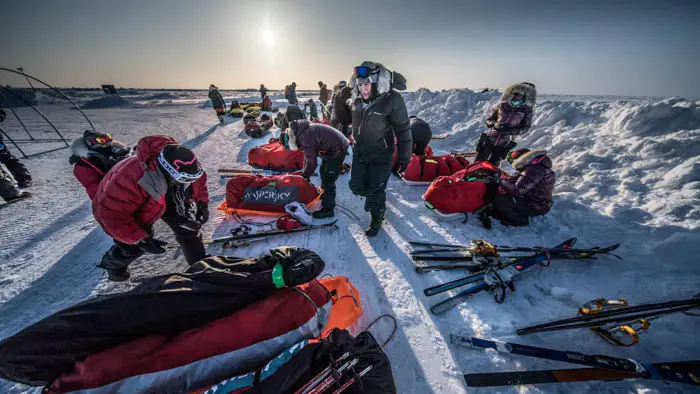Filmmaker Holly Morris has a gift for storytelling. She finds a way for joy to flow in the most extreme and perilous situations, emotional and physical, and to create a connection and a relationship with her subjects that glues an audience to the screen. In Exposure, Morris’s focus on women and their incredible strength from an innate place of intestinal fortitude created history in real-time—and an enduring, entertaining film.
The creative and philosophical decisions Morris makes from the outset separate Exposure from other expedition films. The opening scene of a Muslim chaplain dragging her enormous tractor tire through the streets of Manchester, with honking horns and the sound of ski poles clicking against the sidewalk, is a walk of pure conviction setting the stage for what’s to come. It’s funny not because it’s crazy and out of place but because it’s infused with extraordinary purpose.
“Many viewers expect a death-defying moment out on the ice as an opening,” says Morris. “But this film flips the script from the opening scene onwards—and that value is reflected in every aspect of a very challenging production.”
Capturing a polar expedition requires creative and well-planned filmmaking. Keeping camera batteries functioning in sub-zero temperatures was one challenge, but collecting real-time audio from explorers who could hardly pause for sit-down interviews was even more difficult.

Expedition leader Felicity Aston making sure all sleds were accounted for after the hectic unloading from the An 71 aircraft. Photo by Renan Ozturk
“…the Muslim chaplain, a French biologist, a Qatari princess, and eight other women from the Arab World and the West.”
“Most expedition films, certainly polar expedition films, are narrated,” says Morris. “Because of the temperatures and not being able to interrupt the team’s forward motion, we placed a microphone on each woman 14 hours a day. When we returned to edit in Brooklyn, we had hundreds of hours of wild audio, and once we waded through it, we found the gems—what the women were really saying and experiencing under those layers of Arctic wear. Granted, 90% was panting and swearing, but the other 10% was magic. You don’t capture that if you’re reliant on sit-down interviews that happen after the fact.”
Dragging sledges for 14 hours a day to reach a place only known by its coordinates on a hand-held compass appears scary, but that was only a part of the mission. The result was everything that led to reaching the North Pole, a neutral and visually monotonous environment, which Morris captured with the Muslim chaplain, a French biologist, a Qatari princess, and eight other women from the Arab World and the West.
The authentic human drama Morris captures in Exposure adds to the known environmental drama of climate change, which is at the forefront of the film and an undercurrent to the documentary. Because of the melting ice cap and political conflict in the region, there have been no other expeditions to the North Pole since Exposure was shot.
“Exposure was always going to be a history-making film,” says Morris. “But it’s now an important historical document. The grim reality is that this expedition was likely the last. The degrading Arctic sea ice is its own ticking clock. Scientists predict that it will only hold for another dozen or so years. But it’s also geo-political as this type of expedition is dependent on Russian air support and the seasonally-built Russian Ice Station, Barneo. With the war, none of that is happening. With each passing year, it becomes more and more likely this extraordinary team will be the last, ever expedition to reach the pole.”


